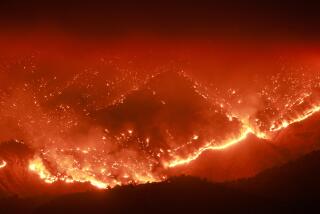The Grandeur of the Groves
- Share via
Sped by hot canyon winds, fueled by dry underbrush, the wildfire ignited swaths of Sequoia National Forest--and then began closing in on its ancient heart. On Thursday, the blaze had moved within two miles of a trail of giant sequoias, close enough for one expert to raise a stunning possibility: The grove could go up in flames.
“If fire does get in the Trail of 100 Giants, we won’t be putting firefighters in there to stop it,” said Jim Paxon, a spokesman for a national team of elite firefighters who were on the scene. He added in the interview with the Associated Press: “It will be a climax of 300- or 400-foot flames.”
In this unrelenting and deadly fire season, the potential scenario prompted a pause to consider the unthinkable. The blaze grew by noon to more than 57,000 acres, and advanced toward iconic places of pilgrimage--besides the Trail of 100 Giants, 10 groves of sequoias were within a mile or so of the flames. In California, the threat took on a personal tone, renewing a proprietary interest in the giant sequoia, which, along with the coast redwood, is the state tree. The sequoias always have been beloved in this state, where they are known by name and forever immortalized by John Muir who described them as “nature’s forest masterpiece, and, so far as I know, the greatest of living things.”
“They have been a core of California’s identity since California became a state,” said Ruskin Hartley, conservation planner for Save the Redwoods League, a San Francisco-based nonprofit. “Those massive columns reaching for the sky are really a sight to behold....The trees just stand there, timeless, removed from the bustle of our everyday lives. There’s something very spiritual about them.”
A U.S. Forest Service spokesman told reporters that saving the “priceless” trees was a top priority. But by Thursday afternoon, despite the efforts of more than 1,500 firefighters and 10 water-dropping aircraft, the fate of the groves remained uncertain.
Only 70 or so groves survive, all on the western slopes of the Sierra Nevada. (In the forest’s Giant Sequoia National Monument, the Trail of 100 Giants is part of a grove that includes 268 sequoias, ranging in age from 500 to 1,500 years old). Giant sequoias are the largest trees on Earth and among the oldest living things. If you have never stood in the humbling shadow of the trees, the way generations of schoolchildren have, it is hard to imagine the grandeur of the groves. The biggest trees are as tall as a 26-story building and as wide as many city streets, with names weighted with history and power: Washington, Genesis, King Arthur.
Douglas D. Piirto, a forestry professor at Cal Poly San Luis Obispo, recalled the first time he realized the stature that the state afforded the trees. In the early 1970s, as a doctoral candidate at UC Berkeley, he got a call from a concerned National Park Service official. Could he figure out why a few giant sequoias had come down? Working with a university professor, Piirto discovered that the culprit was a disease in the root system of the trees.
Throughout the Sierra Nevada, the reaction was telling, said Piirto, who is a member of the Giant Sequoia National Monument Scientific Advisory Board. “People said, ‘Giant sequoias live forever. Nothing attacks them.’ ”
This week, though, the raging wildfire swept away enduring misconceptions of the trees’ immortality. Though the thick tree trunks have withstood countless fires, this blaze could prove to be fatal, Forest Service officials have acknowledged. Pushed by erratic winds, the intense flames have the potential to leap to the upper limbs of the giant sequoias and engulf their entire crowns. But they’re powerless to strip away the still, central place the trees hold in the consciousness of the state.
Artists have long tried to capture their ethereal nature. In “Leaves of Grass,” Walt Whitman mourned and celebrated the giants: “A California song,/A prophecy and indirection, a thought impalpable to breathe as air,/A chorus of dryads, fading, departing, or hamadryads departing,/A murmuring, fateful, giant voice, out of the earth and sky,/Voice of a mighty dying tree in the redwood forest dense ...”
Times staff writer Jeannine Stein contributed to this story.
More to Read
Sign up for Essential California
The most important California stories and recommendations in your inbox every morning.
You may occasionally receive promotional content from the Los Angeles Times.













